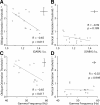Orientation discrimination performance is predicted by GABA concentration and gamma oscillation frequency in human primary visual cortex
- PMID: 20016087
- PMCID: PMC6666191
- DOI: 10.1523/JNEUROSCI.4426-09.2009
Orientation discrimination performance is predicted by GABA concentration and gamma oscillation frequency in human primary visual cortex
Abstract
Neuronal orientation selectivity has been shown in animal models to require corticocortical network cooperation and to be dependent on the presence of GABAergic inhibition. However, it is not known whether variability in these fundamental neurophysiological parameters leads to variability in behavioral performance. Here, using a combination of magnetic resonance spectroscopy, magnetoencephalography, and visual psychophysics, we show that individual performance on a visual orientation discrimination task is correlated with both the resting concentration of GABA and the frequency of stimulus-induced gamma oscillations in human visual cortex. Behaviorally, a strong oblique effect was found, with the mean angular threshold for oblique discrimination being five times higher than that for vertically oriented stimuli. Similarly, we found an oblique effect for the dependency of performance on neurophysiological parameters. Orientation detection thresholds were significantly negatively correlated with visual cortex GABA concentration for obliquely oriented patterns (r = -0.65, p < 0.015) but did not reach significance for vertically oriented stimuli (r = -0.39, p = 0.2). Similarly, thresholds for obliquely oriented stimuli were negatively correlated with gamma oscillation frequency (r = -0.65, p < 0.017), but thresholds for vertical orientations were not (r = -0.02, p = 0.9). Gamma oscillation frequency was positively correlated with GABA concentration in primary visual cortex (r = 0.67, p < 0.013). These results confirm the importance of GABAergic inhibition in orientation selectivity and demonstrate, for the first time, that interindividual performance on a simple visual task is linked to neurotransmitter concentration. The results also suggest a key role for GABAergic gamma oscillations in visual discrimination tasks.
Figures




Similar articles
-
Macromolecule-suppressed GABA measurements correlate more strongly with behavior than macromolecule-contaminated GABA+ measurements.Brain Res. 2018 Dec 15;1701:204-211. doi: 10.1016/j.brainres.2018.09.021. Epub 2018 Sep 19. Brain Res. 2018. PMID: 30244020 Free PMC article.
-
Oscillatory, Computational, and Behavioral Evidence for Impaired GABAergic Inhibition in Schizophrenia.Schizophr Bull. 2020 Feb 26;46(2):345-353. doi: 10.1093/schbul/sbz066. Schizophr Bull. 2020. PMID: 31219602 Free PMC article.
-
Regionally specific human GABA concentration correlates with tactile discrimination thresholds.J Neurosci. 2011 Nov 16;31(46):16556-60. doi: 10.1523/JNEUROSCI.4489-11.2011. J Neurosci. 2011. PMID: 22090482 Free PMC article.
-
GABA concentration is reduced in visual cortex in schizophrenia and correlates with orientation-specific surround suppression.J Neurosci. 2010 Mar 10;30(10):3777-81. doi: 10.1523/JNEUROSCI.6158-09.2010. J Neurosci. 2010. PMID: 20220012 Free PMC article.
-
The role of visual experience in the development of cat striate cortex.Cell Mol Neurobiol. 1985 Jun;5(1-2):103-21. doi: 10.1007/BF00711088. Cell Mol Neurobiol. 1985. PMID: 3896493 Free PMC article. Review.
Cited by
-
GABAergic inhibition shapes behavior and neural dynamics in human visual working memory.Cereb Cortex. 2024 Jan 31;34(2):bhad522. doi: 10.1093/cercor/bhad522. Cereb Cortex. 2024. PMID: 38186005 Free PMC article.
-
Associating neural alterations and genotype in autism and fragile x syndrome: incorporating perceptual phenotypes in causal modeling.J Autism Dev Disord. 2010 Dec;40(12):1541-8. doi: 10.1007/s10803-010-1110-z. J Autism Dev Disord. 2010. PMID: 20872060
-
GABA Levels in Left and Right Sensorimotor Cortex Correlate across Individuals.Biomedicines. 2018 Jul 24;6(3):80. doi: 10.3390/biomedicines6030080. Biomedicines. 2018. PMID: 30042306 Free PMC article.
-
Developmental hearing loss-induced perceptual deficits are rescued by cortical expression of GABAB receptors.bioRxiv [Preprint]. 2023 Jan 10:2023.01.10.523440. doi: 10.1101/2023.01.10.523440. bioRxiv. 2023. Update in: Proc Natl Acad Sci U S A. 2024 Jun 11;121(24):e2311570121. doi: 10.1073/pnas.2311570121. PMID: 36711464 Free PMC article. Updated. Preprint.
-
Design Meets Neuroscience: An Electroencephalogram Study of Design Thinking in Concept Generation Phase.Front Psychol. 2022 Mar 3;13:832194. doi: 10.3389/fpsyg.2022.832194. eCollection 2022. Front Psychol. 2022. PMID: 35310227 Free PMC article.
References
-
- Adjamian P, Holliday IE, Barnes GR, Hillebrand A, Hadjipapas A, Singh KD. Induced visual illusions and gamma oscillations in human primary visual cortex. Eur J Neurosci. 2004;20:587–592. - PubMed
-
- Allison JD, Bonds AB. Inactivation of the infragranular striate cortex broadens orientation tuning of supragranular visual neurons in the cat. Exp Brain Res. 1994;101:415–426. - PubMed
-
- Appelle S. Perception and discrimination as a function of stimulus orientation: the “oblique effect” in man and animals. Psychol Bull. 1972;78:266–278. - PubMed
-
- Bartos M, Vida I, Jonas P. Synaptic mechanisms of synchronized gamma oscillations in inhibitory interneuron networks. Nat Rev Neurosci. 2007;8:45–56. - PubMed
-
- Bonds AB. An “oblique effect” in the visual evoked potential of the cat. Exp Brain Res. 1982;46:151–154. - PubMed
Publication types
MeSH terms
Substances
LinkOut - more resources
Full Text Sources
